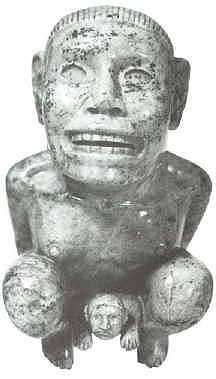PROTO-LANGUAGE PHONEMES
in IE and Sumerian
by Patrick C. Ryan

 (2/12/2001)
(2/12/2001)
PL / IE / SUMERIAN
MORPHOLOGICAL ELEMENTS
(Part Two)
|
(items currently assigned Sumerian or IE equivalents are preceded by S or IE) |

by Patrick C. Ryan

 (2/12/2001)
(2/12/2001)
|
(items currently assigned Sumerian or IE equivalents are preceded by S or IE) |

(A39n) nominal: -NO ("basket"); (Egyptian -n, pronominal plural); (IE
n in -nt, 3rd p. pl.; in -men,
1st p. pl.); (cf. Uralic -n, plural [originally
inanimate]);
(cf. Japanese plural -no in ono (see #6), and
so(-)no, ‘that,
those'; properly a marker of the definite plural)
(A40v)verbal: -N[H]A ("start to . . ."); (IE: not formally recognized but *-l, inchoative [cf.
Armenian infinitive in -l{but possibly from R[H]O, "rise to .
. ."}]); (cf. Basque l-, 3rd person prefix for the
irrealis (see Trask 1997:212-3); (cf. Uralic -l, inchoative
(perhaps this has been weakened to mean only ‘move'); (cf. Beng -N,
inchoative);
(cf. Japanese: Miller 1967
-n-
"perfect" but see p. 326, where it is clearly an inchoative)
(A40n) nominal: -N[H]A-¿E ("moving
inside"), (cf. Afrasian *li, ‘[in]to');
(cf. Japanese ni, locative, [‘into'])
*(A40n1) nominal: -N[H]A ("move inside"); (Basque
-la, forms adverbs of manner (‘moving like . . .'); {see also
NA above}
**(A40n2) nominal: -"N[H]A-(¿E); (IE *-lo (*-li), nouns of the agent); (cf.
Basque -le, agent)
(A41v&n) verbal and nominal: N[H]E
("slippery, slide "); not identified at present
(A42n) nominal: -N[H]O; (IE
*-lo, diminutive)
S(A43v). verbal P[?]A,
("diminutive"); (Sumerian -b-(Verb), verbal chain element, conveying indefinite and partial verbal activity ('some[what]').); (IE only as a root extension in -b; e.g. 4. *(s)ker-, 'cut'; *(s)kerb-, 'score, scratch, gnaw'.) S(A43n). nominal P[?]A,
("partitive"); (Sumerian in -bi {P[?]A-¿E, 'piece-like'}, currently translated as 'its, their', but properly 'someone's'; deriving from ba, 'part'.); (IE in 1. *wi/i:-, 'apart, in two, but also two'); (cf. Egyptian in pj, demonstrative, '**some one')
(A44/45v&n). verbal and nominal P[?]E, ("pour out") / P[?]O, ("swell"); not identified at present
(A46v&n) verbal and nominal: P[?]FA
("protrude"); not identified at present
S*(A46v). verbal P[?]FA-RE + ?A,
("outstanding-make=put-outside=exclude + here"); (Sumerian in **par2-ra-, currently transcribed by Sumerologists as ba-ra-, '(I) exclude here that . . .' {Sumerologists currently regard this formant as expressing the vetitive with marû and the negative affirmative with hamTu verbal forms}); (IE only in the verbal roots 1. *bher-, 'carry, bring (away)'; and *3. bher-, 'split off') S(A47n) nominal: P[?]FE-(¿E) ("foot-like = at the feet
of, by, under, around"); (Sumerian in bî2- (better **pî5-), verbal prefix, 'around'); (IE *bhi-, "by, around", listed under *ambhi-,
‘all around, on both sides'; in Greek "locative" -phi); (cf. AA: Egyptian only in combination: m b(j)(w), 'in the place of'; Arabic bi, 'by, at, in, with'); (cf. Basque -b/pe, ‘under'; (cf. Hurrian -(a)bi, 'before (postposition)'); (cf. Urartian -pei, 'under (postposition)')
(A48n) nominal: P[?]FO-¿E, ("leg-like, on top of");
(IE (*ebhi[?]), ‘upon something, thereupon and overpowering
it' [?E-, "there"+])
S(A49n) nominal: P[H]A ("over");
(Sumerian ba-, verbal prefix, glossed by Akkadian
perfect in -t); (IE po/o:, a perfectivizing verbal prefix, listed under apo-, 'off, away'; in *pero-s, ‘earlier'; *peri-, ‘before', listed under *2. per-, ‘lead out over'); (cf. Egyptian p3, former of past perfects); (cf. Basque b-, prefix of
3rd person jussive verbs; cf. ba, ‘already')
(A50/51v&n) verbal and nominal P[H]E, ("small") / P[H]O, ("sniff"); not identified at present
(A52/53/54v&n) verbal and nominal P[H]FA, ("fat") / P[H]FE, ("sting") / P[H]FO, ("puff"); not identified at present
(A55/56v&n) verbal and nominal QA, ("tubular") / QE, ("congeal"); not identified at present
(A57v) verbal: QO ("attached"); (cf. Uralic
Nenets -ng?, essive); cf. Altaic -q in genitives
[-i/?q = ¿E-QO or ¿E-QA;
-ni/?q = NA-¿E-QO or NA-¿E-QA]);
(cf. Japanese ga, emphatic subject [but Japanese
a for o is unexplained])
(A57n) nominal: -QO ("skull, pot"); (IE *-ng collectives); (cf. Uralic
-ka/ä, non-singular)
S*(A57n1) nominal: QO ("skull = animate
entity"); (Sumerian (n)g3a10, ‘I'); (cf. Beng
qa, ‘they [with negatives]';
qO [*qo + va, imperfective], ‘they [with
present/future]'); this use of QO is particularly frequent in Australian
languages
S**(A57n2) nominal: QO(-?A) ("be attached"); (Sumerian -(n)ga- [a better reading for J. #594 in my opinion is the attested Akkadian -(n)gu(-u), which I would indicate as -(n)g3u/ûx], modal prefix,
‘also' [in texts older than Old Babylonian, the prefix is always written -ga- but in Old Babylonian and later, it is normally written in-ga. Thomsen 1984 says on page 170: "The form of this prefix is normally considered to be /inga/ or /nga/." If the initial i- is not derived from i3, the normal sign of non-concomitant time (PL ?E), then it may represent the first element of IE *eng or Egyptian [j]gr.]); (IE
*(n)go:, 'behind, after, on account of', listed under *g[^]ho:; *eng- in *en-dh-, ‘and', listed incorrectly under *en-); (cf. Egyptian in [j]gr, ‘also'); (cf. Uralic Nenets ngo?, ‘also'); (cf. [Sino-]Tibetan -ang in ky+ang, ‘also'); (cf. Japanese -go:, ‘after' [-> MJ go])
(A58/59v&n). verbal and nominal Q[H]A, ("hard, humped, elevated") / Q[H]E, ("bustle"); not identified at present
(A60n) nominal: Q[H]O ("hooked"), (cf.
Beng possibly in
?aaN, ‘hear now, well'; perhaps doubtful)
(A61v&n). verbal and nominal RA, ("tree"); not identified at present
(A62v) verbal: RE ("scratch, (any) one"); (IE in Latin -r, passive ending); (cf. Basque in
ra-,
causative prefix; -erazi, causative suffix (Trask 1997:231);(Japanese -r-
, passive)
(A62n) nominal: -RE ("scratch" = indefinite number);
(Egyptian in p-3, ‘**any one', as against p-n, ‘the'
(P[?]A-N/N[H]A); *jp-, ‘ones'
(¿A-P[?]A)); (cf. Japanese in so(-)re, ‘it,
that'); (cf. [Sino-]Tibetan -re, ‘each', distributive); (cf.
Altaic -a/er, distributive); properly, -RE is a marker of the
indefinite singular
*(A62n1) nominal: "RE-¿E; (Sumerian -ri, ‘that, yonderI'); (IE *re:i-, ‘number', listed incorrectly under *1.
ar-); (cf. Japanese -ri, single (any one), in
hito-ri, ‘single man')
(A63v) verbal: RO (augmentative); not identified at present.
(A63n) nominal: -RO (elative); (IE *-ro, comparative); (cf. Beng -l/r,
augmentative);
(cf. Japanese *-ro but not recognized as a suffix)
(A64n) nominal: R[H]A (color formant); (IE *-r, terminating color words); (cf. Beng -l in
kala, ‘elderly person')
(A65v&n) verbal and nominal: R[H]E ("rain, fall"); not identified at present
(A66v) verbal: R[H]O ("rise"), (IE for *lo = ‘rise', cf. OHG ti-la, ‘women's
breast', and Greek tú-lo-s, ‘swelling'; cf. *-lo, nouns of agent
and instrument [this is from "give rise to"]); (cf. the Japanese imperfect
ending -ru = either PL RE ("apply") +
FA (imperfective) [cf. Egyptian -3] or
R[H]O-F[H]A [Armenian infinitive in -l]; (cf.
Japanese *-ro: (-> MJ -roo), presumptive, ‘rise to . . . , intend to')
(A66n) nominal: -R[H]O; (IE
-lo, augmentative)
(A67n) nominal: -SA(-¿E) or
SA-FE ("strong[-like] {unbreakable}" or
"strong-powerful"); (IE *-s, aorist; *s-mobile;
or *su-, ‘well'); (cf. Old Basque *Z-, which has
the effect of de-leniting initial consonants in a word; -tza, ‘abundance, large amount
of, collectivity'; or -zu / *-tzu (-tsu
[SA-¿E-FE [?]]), "full of"; Biscaian ze-, past tense prefix
when no other agreement prefix present {see (A2) above}); (cf. Uralic Nenets
-sy, "past tense" or so/wa, ‘good'); (cf. Japanese
súu-, ‘several').
(A68n) nominal: SE ("individual", inanimate);
see S[H]E below.
(A69v&n) verbal and nominal: NO ("skin, pull "); not identified at present
(A70n) nominal: S[H]A ("content = serene"); (IE desiderative / future in -*s); (cf. Japanese
-*s(a:)-, marker of respect (-> MJ -mas-u
(MA-S[H]A, "fully happy"; cf. masáru,
‘surpass, excel'; Miller 1967:326)
*(A70n1) nominal: S[H]A ("rest, place"); (IE *-s, nouns of quality [cf. Old Indian
tápa-s, ‘warmth']; Mediterranean place names in -isso);
(cf. Basque -z, instrumental; in -zko, ‘made of . . .'
(+ KX[H]O-F[H]A, "cutting"; IE *1. (s)keu-, ‘get ready, carry
out'; *6. ske:u-(t-), ‘cut, separate, scratch, score, puncture, poke through');
-tz, *stative, in gaitz, ‘bad'; putz / futz, ‘puff
of air'; -tza, stative, in bizitza, ‘life'); (cf.
[Sino-]Tibetan -sa, ‘place of . . . ‘); (cf. Uralic -s(s)a,
inessive); (cf. Japanese *-sa:, noun of quality or place)
**(A70n2) nominal: S[H]A ("rest, place"); (IE possibly *-s- in *-sk[^]o); (cf. Basque
-tza, job or profession); (cf. Japanese -s-, adjectivizer, in
aka-s-i, ‘be red')
***(A70n3) nominal: S[H]A ("female"); (IE *-sa in *-i-sa, feminine [cf. Latin
-issa]); (cf. Basque -sa, female); (cf. Nama
-s, female)
(A71v) verbal: S[H]E ("individual"); (cf.
Japanese -se, causative); see (A6) verbal:
¿O above.
S(A71n) nominal: S[H]E(-¿E) ("individual(-like)"); (Sumerian šê, ‘one' ); (IE singular in *-s); (cf. Altaic as -z,
Turkish suffix of one of objects occurring in pairs); (cf. Beng in sia,
‘male')
S*(A71n) nominal: -S[H]E ("separate [for]"); (Sumerian -šê3-; New Sumerian, -Vš, ‘towards'); (IE genitive singular and dual forms in *-s / *-(ou)s)
(A72v) verbal: S[H]O ("clan-member=same=so");
(IE *swe-, ‘*same', listed incorrectly under *se-;
*mes-, listed under *1. e:-); (cf. Japanese *-s in
negative irrealis -z- (from *-n-i-s-
[NA-?A-¿E-S[H]O = "not so"]; Miller 1967:327); and -mas
[M[H]A-S[H]O = "hold so"]; Miller 1967:327)
*(A72v1) verbal: S[H]O ("clan-member=person");
(Egyptian s-, causative); (IE
some *s-mobile may be causative rather than intensive);
(cf. Basque z-, prefix of the third person past (really properly an
intensive) {see also (A2) above})
S**(A72v2) verbal: S[H]O-¿E ("follow-like"); (Sumerian sü5- {Jaritz Sign #893, read by Sumerologists as še3-}, ‘so, it follows that . . .'; through scribal confusion, also written in Old Sumerian as ši-; later, in Old Babylonian, written ši-; and because of the reading ša16 for Jaritz Sign #893, written ša- and very late, ša3-; and with some dim remembrance of sü5-, also occasionally written šu-); (IE *se:i-, ‘so', listed under se-); (cf. Japanese shi, ‘and')
(A72n) nominal: S[H]O ("clan=good"); (IE in *su-, ‘good'); (cf. Basque -so,
family relationship); (cf. Japanese OJ so:-, intensive prefix)
*(A72n1) nominal: S[H]O-¿E ("clan-member-like");
(Egyptian -s(j), ‘she'); (IE
secondary *-s, 2nd p. sing. of active; *syo-, ‘this', listed under
*so[s]); (cf. Altaic -si/?, 3rd p. sing.; in
sen, ‘you [sing.]'); (cf. Uralic sä, ‘he/she/it'); (Beng in
sO\N, ‘person, someone, somebody, body'); (cf. Japanese in
so(-)re, ‘it, that'; so-no, ‘that, those')
**(A72n2) nominal: S[H]O ("clan[-member]"); (IE in *-es, nominative plural); (cf. Basque
-z, plural absolutive verbal suffix (see Trask 1997: 221-2))
S(A73n) nominal: T[?]A ("hand"); (Sumerian -da / -da5 (Old Sumerian), "locative", really lative but shading into comitative ['with']); (IE *de-, demonstrative stem, ‘I'-deictic in part; cf. Greek dé:, ‘even, now, just, certainly'); (cf. Basque d-- as a third person prefix for present tense verbs); (cf. Beng in díN, ‘next to'); (cf. Altaic -de/a, locative; (a lative [‘at the side of, with'] in languages all over the world; seen dimly in IE ablative -e:/o:d, possibly a metathesis of *-d+e: (T[?]A+HHE, "go away from the hand") to facilitate pronunciation of vowelless stems); (cf. Uralic -t(Vogul), locative); (cf. Japanese de (from "T[?]A-¿E), ‘at/in/on (the hand of); by means of (through the hand of)')
(A74/75v&n). verbal and nominal T[?]E, ("heel, spin around") / T[?]O, ("torso, put together"); not identified at present
(A76/77v&n). verbal and nominal T[H]A, ("dew, steal, damp") / T[H]E, ("star, shine, contract"); not identified at present
(A78v) verbal: -T[H]O, ("approach, gather"); (IE *2. to-); (cf. Uralic *-ta/ä,
allative (‘toward') [cf. Nenets dative -n~to/-h]); (cf.
Japanese to, ‘and, as soon as')
S*(A78v1) verbal: -T[H]O (iterative); (Sumerian -da (better -du20), iterative of a marû verb formed by -î or a hamTu form); (IE *-to, perfective passive participle); (Egyptian sDm.t.f, pluperfect; -t, infinitive of verbs in -j); (cf.
Altaic -d/t, perfective); (cf. Japanese -ta, perfect [the
a for expected o is unexplained]); also -t-, perfect (Miller
1967:326)) S(A78n) nominal: T[H]O (definite animate plural); (Sumerian -d, 'herd of . . .' in gûd, 'cattle', from gû4, 'steer'); (IE *1. to-, ‘this'); (cf. Basque -to, augmentative)
*(A78n1) nominal: -"T[H]O-¿E ("tribesman-like");
(IE *-ti, nomina agentis and nomina
actionis; [cf. IE *sru-ti-s, 'a flowing, streaming', from
*sreu-); (cf. Basque -te, gerund); (cf.
Uralic -tya in kun-tya, ‘urine'); (cf. Japanese
-te, ‘one who performs . . .', gerund)
**(A78n2) nominal: -"T[H]O-¿E ("tribesman-like");
(IE *-ti, collective); (cf. Basque
-te, ergative NP plural verbal suffix (see Trask 1997:221-2); -te,
‘abundance'; -ti, ‘group of men' (T[H]O-"¿E)
(A79v&n) verbal and nominal: T[?]SA ("long, body"); not identified at present
(A80v) verbal: T[?]SE-FA ("releasing=going away");
(IE *dheu-, listed under *3. dhe:-,
‘disappear'); (cf. Japanese -zu, negative)
*(A81v). verbal T[?]SO, ("swing [around]"); not identified at present
S*(A81n) nominal T[?]SO(-FA),
("swing [around]" + imperfective = 'drilling' = 'removing from'); (Sumerian -tûx (read by Sumerologists as -ta [Jaritz Sign #240]), 'from, by'; termed by Sumerologists: "ablative-instrumental"); (IE in *-dhen, '*(remove) from', in Greek postposition -then)
(A82/83v&n). verbal and nominal TS[H]A, ("rear up, excessive") / TS[H]E ("bristle up, frightened"); not identified at present
(A84n) nominal: TS[H]O (circle of animates); (IE in -*tu, forms abstract substantives
(TS[H]O-F[H]A)); (cf. [Sino-]Tibetan
-tsho, plural)
*(A84n1) nominal: TS[H]O ("circling"); (IE in *ter-, ‘there' [Egyptian '3], listed incorrectly under
*1. to-); (cf. Uralic "essive" -ta); (cf. Japanese to, ‘[along] with')
**(A84n2) nominal: TS[H]O; (IE *to, ‘then', under *1. to-); (cf.
Japanese
to, ‘when')
(A85/86v&n). verbal and nominal XA,
("swallow, slit") / XE, ("fur, feather, prick"); not identified at present
(A87v)verbal: XO, ("squirt, below");
(Egyptian in *Xr {XO-RO, "below-part"},
‘under')
(A88v)verbal: X[H]A-F[H]A ("resting=(be)come");
(IE *kwe- in kwey6-); (cf.
Japanese -k[w] in forms of adjectives except non-past indicative, from
kú-ru, 'come')
(A89v&n). verbal and nominal X[H]E, ("curl
around, encircle"); not identified at present
(A90n) nominal: X[H]O (large indefinite animate
plural); (cf. Egyptian S in jSzt, ‘what?'
[S <- X]); (IE *kwo-,
indefinite); (cf. Japanese ka, interrogative particle ('what?');
indefinite [the
Japanese a for expected o is unexplained])
*(A90n1) nominal: X[H]O-HA ("at the quantity"); (cf. IE *kwei-, ‘as', listed under *kwo- [‘of the
quantity of']); (cf. Uralic Nenets simulatives in -r-xa);
(cf. Altaic -ca, aequativus) [‘at the
quantity of']); (cf. Japanese koo, ‘this way')
S(B1) nominal: HHA-(¿E)-KX[H]O
("water-like=sea+shell=property"); ( Sumerian genitive -ak); (IE *e:ik-, ‘have as one's own; be able to'; cf. Hittite aku-, 'sea-shell(?)'); (cf. Basque ergative *-ek)
S*(B2) (S)OV is the earliest Sumerian word-order, corresponding to
OV established by Lehmann for earliest IE; S-OV
(and possibly OV-S, which may have distinguished between
imperfective and perfective aspects before singular and plural elements
were applied to convey the same aspects) word-order stems from the language of the
active-type phase, where the transitive subject is only loosely linked to the
object-"verb", which is primary, and need not be expressed overtly, a characteristic which
many active/ergative-type languages amply illustrate; Basque, Beng (Southern
Mandé), Japanese and Basque also have SOV,which should also be
assumed for Altaic and Uralic (proved by the invariable rectum-regensword
order of Uralic and Altaic [except Northern Tungus]).
S*(B3v) verbal: REDUPLICATION indicates
habituality, i.e. 'always': (Sumerian reduplication(Verb), e.g., amaš ha(better ku6)-ra-dag[~]al-dag[~]al, 'the sheepfolds must always be wide up (there)'; however, it seems also to be have been used for the related concept of 'all': alam-bi i3gul-gul, 'he destroyed all of its statues'.{see Thomsen 1984:123-27.}); (IE: partial reduplication: "Frequentative, iterative, and also intensive aspect was expressed by reduplication (Lehmann 1974:188)."); (cf. Egyptian reduplication, habitual: e.g. Ddd.t, ‘what has always been said'); (cf. Japanese ; when the iterative -*to (-ta) began to be used for the perfective, reduplication was re-defined as iterative: when *ker-, ‘*run', is reduplicated, the vowel -a- represents a stress un-accented root -e-: *ke"ker becomes kakér-u, ‘run'; kák-u, ‘write'; stem: ka(i)-). S*(B3n) nominal: REDUPLICATION indicates
totality, i.e. 'all': (Sumerian reduplication(Noun), e.g., kur-kur, 'all foreign countries'; contrasting with kur, 'one or more foreign countries' {Thomsen 1984:59}; adjectives, as a sub-class of nouns, may also be reduplicated; Thomsen (1984:65) adopts the interpretation of adjective reduplication as a superlative: gal-gal = 'greatest' but though I believe it may have been functionally equivalent, I think the better translation is 'always great'.); (IE apparently not regularly used in nouns.)
*(B4) cf. Basque -u, circumlocative, in gu, "we, (to and
for) us"; and
zu, "(to and for) you (singular but formerly plural); (Japanese consevatively preserves
archaic features of the Proto-Language (active-type) period, during
which the transitive subject formed a separate sub-phrase of the sentence, and was frequently
deleted.
When the context required it to be included, the early ergative-type sub-phrases were
formed: S + F[H]A, literally, (something) is 'circling around' the
S, which is actually a topicalizer rather than a formative of the
ergative subject; this element is very old; we can see it in *-su, the IE
locative plural (*-s + *-u); and possibly the Latin nominative in
-u; and in IE pronominal forms with *-w, e.g. *tewe; in
-w, the Egyptian independent pronoun ending (zw, 'he' [topic
{subject} of stative]; 'him' [topic {not object} of transitive verb]); cf.
Afrasian nominative
in *-u; cf. Hurrian dative (of interest) -wa.
**(B5) (cf. Japanese: the direct object marker (*w)o is a
relatively late
innovation; according to Shibatani
(1996:340), "it was more common not to mark the direct object at all" in the earliest
records; this is the most archaic pattern; in spite of the Japanese orthographical details, this
particle seems to mean "toward", which would suggest a derivation from PL
HHO, "come down on" (cf. IE 1. o, to, with;
[cf. Egyptian h3]); this correlates better with the Japanese vocative
and hortative use of o (cf. IE 2. o:, vocative).
suffices for a preliminary study to establish the
presumption of a genetic relationship.

for modifications of the vowels and consonants in combination,
see the
Table of Modifications
In order for readers to judge the semantic plausibility of the analysis of
Proto-Language (PL) compounds suggested here, I
am including access to a table of
Proto-Language monosyllables and the meanings I have
provisionally assigned.
Most assignments can be exhaustively supported by data from actually attested forms but
a few animates are very doubtful; and this list does not represent the "final" solution of these
questions, which will only be approached when other scholars assist in refining it.
Patrick C. Ryan
Summer 1998
![]()
the latest revision of this document can be found
at
HTTP://WWW.GEOCITIES.COM/Athens/Forum/2803/c-SUMERIAN-5_morphology-2.htm

Patrick C. Ryan * 9115 West 34th Street - Little Rock, AR
72204-4441 * (501)227-9947
PROTO-LANGUAGE@email.msn.com